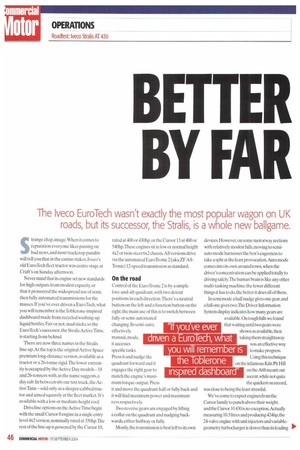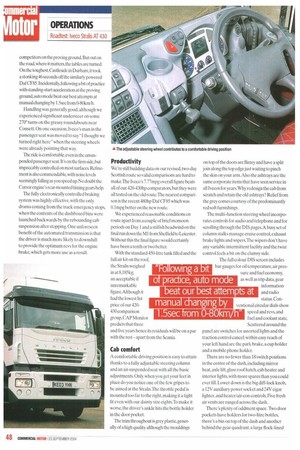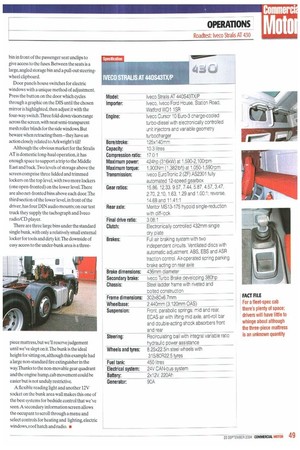BETTER BY FAR
Page 46

Page 48

Page 49

If you've noticed an error in this article please click here to report it so we can fix it.
The Iveco EuroTech wasn't exactly the most popular wagon on UK roads, but its successor, the Stralis, is a whole new ballgame.
Strange chap, image. When it comes to reputation everyone likes passing on bad news, and most truckstop pundits will tell you that in the canine stakes. Iveco's old EuroTech fleet tractor was centre stage at Craft 's on Sunday afternoon.
Never mind that its engine set new standards for high outputs from modest capacity, or that it pioneered the widespread use of semi, then fully automated transmissions for the masses. If you've ever driven a EuroTech, what you will remember is the Toblerone-inspired dashboard made from recycled washing-up liquid bottles. Fair or not. mud sticks, so the EuroTech's successor, the Stralis Active Time, is starting from behind.
There are now three names in the Shahs line-up. At the top is the original Active Space premium long-distance version, available as a tractor or a 26-tonne rigid. The lower extremity is occupied by the Active Day models —18 and 26-tonners with, as the name suggests, a day cab. In between sits our test truck, the Active Time — sold only as a sleeper-cabbed tractor and aimed squarely at the fleet market. It's available with a low or medium-height roof.
Driveline options on the Active Time begin with the small Cursor 8 engine in a single entry level 4x2 version,nominally rated at 350hp.The rest of the line-up is powered by the Cursor 10, rated at 400 or 430hp:or the Cursor 13 at 480 or 540hp.These engines sit in low or normal height 4x2 or twin-steer 6x2 chassis.All versions drive via the automated EuroTronic 2 (aka ZF ASTronic) 12-speed transmission as standard.
On the road
Control of the EuroTronic 2 is by a simple fore-and-aft quadrant, with two detent positions in each direction. There's a neutral button on the left and a function button on the right: the main use of this is to switch between fully or semi-automated changing. In semi-auto, effectively manual,mode, it accesses specific tasks. Press it and nudge the quadrant forward and it engages the right gear to match the engine's maximum torque output. Press it and move the quadrant half or fully back and it will find maximum power and maximum revs respectively.
Two reverse gears are engaged by lifting a collar on the quadrant and nudging backwards, either halfway or fully.
Mostly, the transmission is best left to its own devices. However, on some motorway sections with relatively modest hills, moving to semi auto mode harnesses the box's eagerness to take a split at the least provocation.Auto mode comes into its own around town,when the driver's concentration can be applied totally to driving safely The human brain is like any other multi-tasking machine: the fewer different things it has to do, the better it does all of them.
In sernimode a half nudge gives one gear, and a full one gives two.The Driver Information System display indicates how many gears are available. On tough hills we found that waiting until two gears were shown as available, then taking them straightaway was an effective way to make progress Using this technique on the infamous Kiln Pit Hill on the A68 meant our ascent,while not quite the quickest on record, was close to being the least stressful.
We've come to expect engines from the Cursor family to punch above their weight, and the Cursor 10 430 is no exception.Actually measuring 10.3 litres and producing 424hp, the 24-valve engine with unit injectors and variable geometry turbocharger is slower than its leading 00 competitors on the proving ground. But out on the road,where it matters. the tables are turned. On the toughest, Castleside in Durham, it took a stonking 46 seconds off the similarly powered Daf CF85. Incidentally, following a bit of practice with standing-start acceleration at the proving ground,auto mode beat our best attempts at manual changing by 1.5sec from 0-80km/h.
Handling was generally good, although we experienced significant understeer on some 270° turns on the greasy roundabouts near Consett. On one occasion, Iveco's man in the passenger seat was moved to say "1 thought we turned right here" when the steering wheels were already pointing that way.
The ride is comfortable, even in the unsuspended passenger seat. It's on the firm side,but impeccably controlled on most surfaces.Refinement is also commendable,with noise levels seemingly falling as you speed up.No doubt the Cursor engine's rear-mounted timing gears help.
The fully electronically controlled braking system was highly effective, with the only drama coming from the track emergency stops, when the contents of the dashboard bins were launched backwards by the rebounding cab suspension after stopping. One unforeseen benefit of the automated transmission is that the driver is much more likely to downshift to provide the optimum revs for the engine brake, which gets more use as a result.
Productivity
We're still building data on our revised, two-day Scottish route so valid comparisons are hard to make.The Iveco's 7.77mpg overall figure beats all of our 420-430hp comparators, but they were all tested on the old route.The nearest comparison is the recent 480hp Daf CF85 which was 0.1mpg better on the new route.
We experienced reasonable conditions en route apart from a couple of brief monsoon periods on Day 1 and a stiffish headwind on the final rundown the M1 from Sheffield to Leicester. Without this the final figure would certainly have been a tenth or two better.
With the standard 450-litre tank filled and the full air kit on the roof, the Stralis weighed in at 8,185kg; an acceptable if unremarkable figure. Although it had the lowest list price of our 420430 comparison group, CAP Monitor predicts that three and live years hence its residuals will be on a par with the rest— apart from the Scania.
Cab comfort
A comfortable driving position is easy to attain thanks to a fully adjustable steering column and an air-suspended seat with all the basic adjustments. Only when you get your feet in place do you notice one of the few gripes to be aimed at the Stralis.The throttle pedal is mounted too far to the right, making it a tight fit even with our dainty size eights.To make it worse, the driver's ankle hits the bottle holder in the door pocket.
The trim throughout is grey plastic, generally of a high quality although the mouldings on top of the doors are flimsy and have a split join along the top edge just waiting to pinch the skin on your arm. Also the ashtrays are the same corporate items that have seen service in all Ivecos for years. Why redesign the cab from scratch and retain the old ashtrays? Relief from the grey comes courtesy of the predominantly red soft furnishings.
The multi-function steering wheel incorporates controls for audio and telephone and for scrolling through the DIS pages. A busy set of column stalks manage cruise control, exhaust brake lights and wipers:The wipers don't have any variable intermittent facility and the twist control feels a bit on the clumsy side.
The full colour DIS screen includes bar gauges for oil temperature, air pressure and fuel economy, as well as trip data, gear information and radio status. Conventional circular dials show speed and revs, and fuel and coolant state. Scattered around the panel are switches for assorted lights and the traction control cancel; within easy reach of your left hand are the park brake, a cup holder and a mobile phone holder.
There are no fewer than 18 switch positions in the centre of the dash. including mirror heat, axle lift, glass roof hatch, cab heater and interior lights, with more spares than you could ever fill. Lower down is the big diff-lock knob, a 12V auxiliary power socket and 24V cigar lighter, and heater/air-con controls. Five fresh air vents are ranged across the dash.
There's plenty of oddment space .Two door pockets have holders for two-litre bottles, there's a bin on top of the dash and another behind the gear quadrant:a large flock-lined bin in front of the passenger seat unclips to give access to the fuses. Between the seats is a large, angled storage bin and a pull-out steeringwheel clipboard.
Door panels house switches for electric windows with a unique method of adjustment. Press the button on the door which cycles through a graphic on the DIS until the chosen mirror is highlighted, then adjust it with the four-way switch.Three fold-down visors range across the screen, with neat semi-transparent mesh roller blinds for the side windows. But beware when retracting them — they have an action closely related to Arkwright's till!
Although the obvious market for the Stralis AT is domestic long-haul operation, it has enough space to support a trip to the Middle East and back.Two levels of storage above the screen comprise three lidded and trimmed lockers on the top level, with two more lockers (one open-fronted) on the lower level.There are also net-fronted bins above each door.The third section of the lower level, in front of the driver, has four DIN audio mounts; on our test truck they supply the tachograph and Iveco radio/CD player.
There are three large bins under the standard single bunk,with only a relatively small external locker for tools and dirty kit.The downside of easy access to the under-bunk area is a three piece mattress,but we'll reserve judgement until we've slept on it.The bunk is the ideal height for sitting on, although this example had a large non-standard fire extinguisher in the way.Thanks to the non-movable gear quadrant and the engine hump, cab movement could be easier but is not unduly restrictive.
A flexible reading light and another I2V socket on the bunk area wall makes this one of the best systems for bedside control that we've seen. A secondary information screen allows the occupant to scroll through a menu and select controls for heating and lighting,electric windows, roof hatch and radio. •




























































































































































































